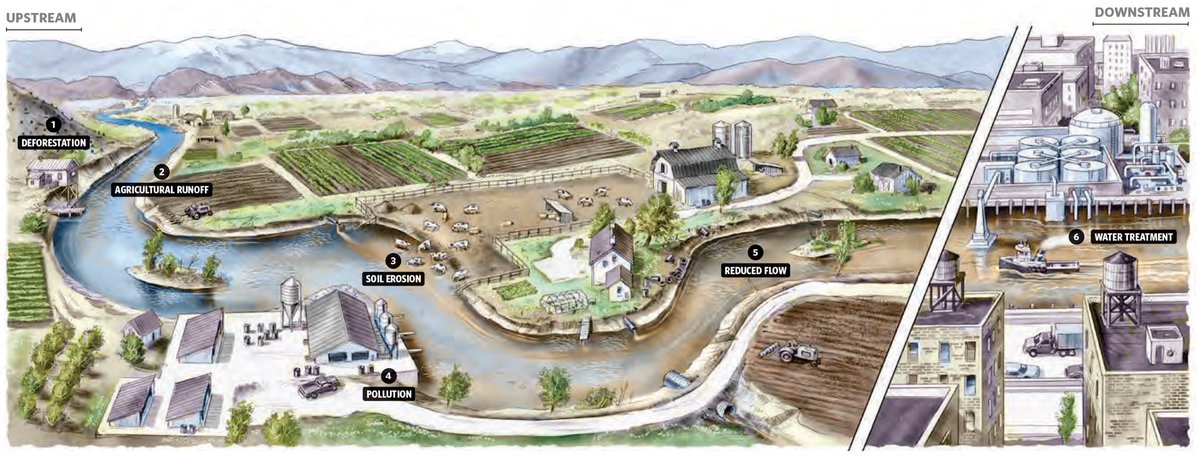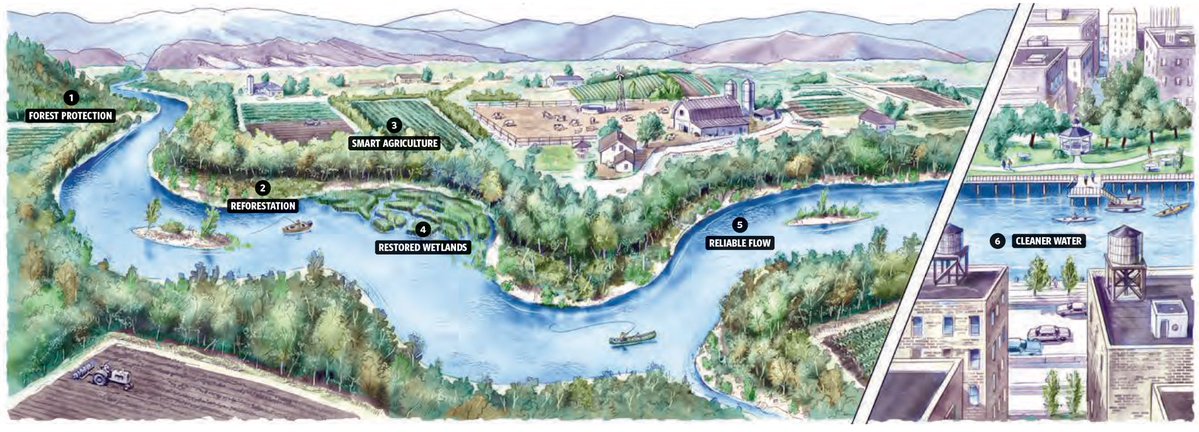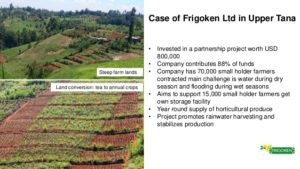What’s A Conservation Water Fund?

You who may be subscribers to “Nature Conservancy” magazine might have noticed an article in the just-released Summer 2017 edition called: “Liquid Assets: Five large cities invest in upstream conservation to improve water quality for their residents.” (“Liquid Assets” is the principal source of this post, particularly as to the infographics shown here, the keys to them and quote marks denoting article text.)
The cities are: São Paulo, Brazil; Nairobi, Kenya; Albuquerque and San Antonio, NM and Savannah, GA.
What immediately caught my attention is the 2-part infographic shown here about how conservation practices upstream of cities protect their water supplies while saving money.
The first infographic is of a degraded watershed–

“In many cities worldwide,” where watersheds are degraded, “drinking-water supplies are greatly affected by how land is managed. Practices that clear forests, increase erosion and create pollution reduce both water quality and reliability.”
The key to this infographic describes each denoted data point-
- DEFORESTATION: Clearing forests and other vegetation increases the erosion of soil. The sediment pollutes nearby waterways and makes filtration more difficult and expensive.
- AGRICULTURAL RUNOFF: Rain washes fertilizers and other chemicals into nearby water sources, polluting the city’s drinking-water supply.
- SOIL EROSION: Livestock entering waterways trample the riverbank, contributing to sedimentation. Fecal waste in the water increases the risk of disease.
- POLLUTION: Some agricultural runoff drains through pipes directly into waterways. Oil and rubbish from roads wash into rivers.
- REDUCED FLOW: Agricultural soils and industrial surfaces have less ability to absorb and slowly release rain than naturally vegetated soils do. This deficiency results in less water during dry times and more flooding when it rains.
- WATER TREATMENT: Urban centers receive dirty water that often can be unsafe for human consumption.
An accompanying Return on Investment sidebar graphic, showing a glass of murky water, reads: “Water users pay a significant cost for industrial treatment of direct water when it reaches the city.”
This second graphic is of a healthy watershed–

- FOREST PROTECTION: Protecting forests and grasslands sustains wildlife habitat, reduces erosion, and safeguards the quality and reliability of downstream water flows.
- REFORESTATION: Replanting forests reduces erosion, captures carbon and expands habitat.
- SMART AGRICULTURE: Planting cover crops on fallowed fields and fencing livestock away from the river reduce erosion and prevent pollution. Adding trees around crops and pastures can also enhance farms and ranch income.
- RESTORED WETLANDS: Wetlands help filter pollutants and provide critical habitat for plants and animals.
- RELIABLE FLOW: Naturally vegetated soils hold water when it rains and release it slowly, which helps sustain more predictable river flows.
- CLEANER WATER: A well-managed watershed delivers a clean and reliable supply of water, so cities spend less on water treatment and filtration for human use.
Showing a clear glass of water, the healthy watershed Return on Investment sidebar reads: “Rather than pay for expensive industrial filtration, water users pay upstream landowners to use good farming practices and to conserve or restore natural areas that protect water at the source.”
I could report on San Antonio, a TX city that fascinates me ’cause I have yet to visit its highly acclaimed River Walk.
But a sense of environmental justice for the water-deficit country of Kenya causes me to share information about Nairobi’s water problems and a water fund solution being implemented.
 Over the last 25 years and some, Nairobi’s population has doubled to 4m. 95% of these rely on water from the mountainous Upper Tana River watershed. Hillside agriculture during these recent years has “exacerbated erosion that periodically chokes the city’s water system with silt, stopping water service for days.” Of late, the Nature Conservancy has stepped in to work with the Kenyan government, utilities and corporations (including intensive water users Coca-Cola and East Africa Breweries) to create a conservation water fund.
Over the last 25 years and some, Nairobi’s population has doubled to 4m. 95% of these rely on water from the mountainous Upper Tana River watershed. Hillside agriculture during these recent years has “exacerbated erosion that periodically chokes the city’s water system with silt, stopping water service for days.” Of late, the Nature Conservancy has stepped in to work with the Kenyan government, utilities and corporations (including intensive water users Coca-Cola and East Africa Breweries) to create a conservation water fund.
 Erosion control has been enhanced by terraced farming and buffer zones along streams at about 15k farms, funded by the Governance Board of the Nairobi Water Fund. Other initiatives have been put in place.
Erosion control has been enhanced by terraced farming and buffer zones along streams at about 15k farms, funded by the Governance Board of the Nairobi Water Fund. Other initiatives have been put in place.
Late last year, “water clarity levels approached World Health Organization standards for the first time since measurements began.”
Unfortunately, water rationing requirements were instituted 1/1/17 by the Nairobi county government. Lesser rainfall beginning in May 2016 led to slower recharge of the rivers feeding the Ndakaini dam at the lower boundary of the Upper Tana River watershed which as of mid-April was 21% of its usual level.
But, it could have been worse were it not for the measures started in the upstream watershed.